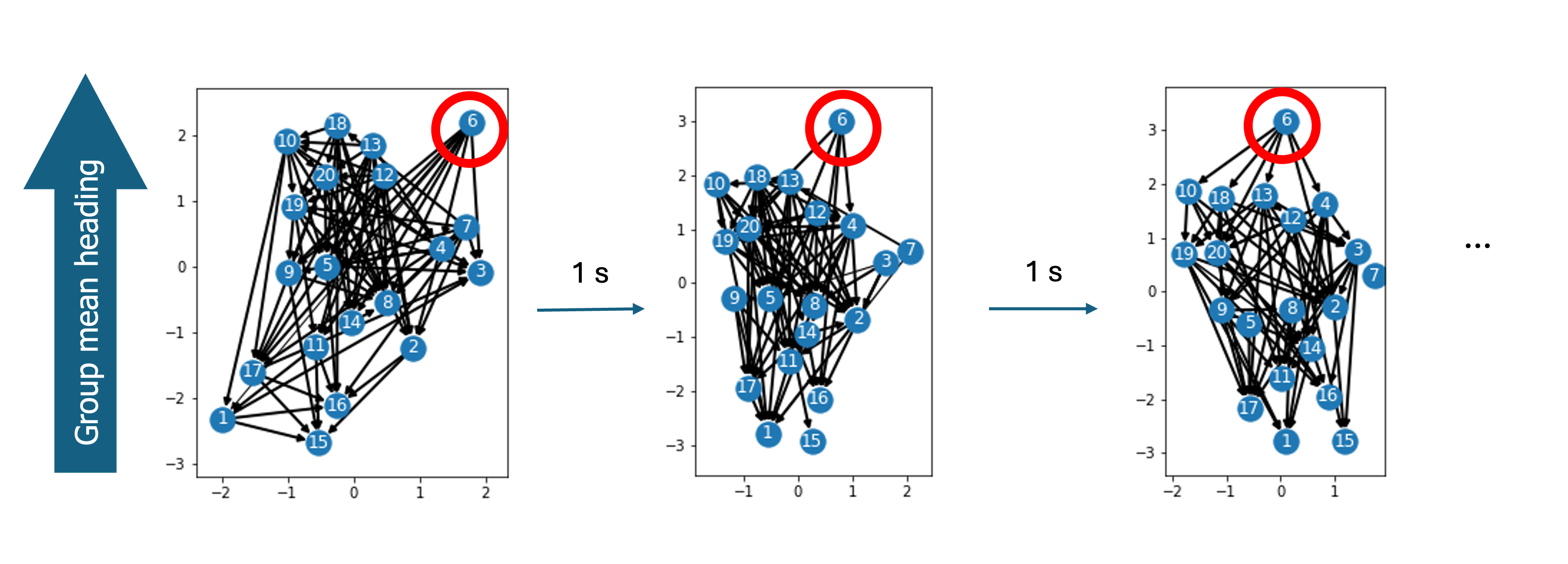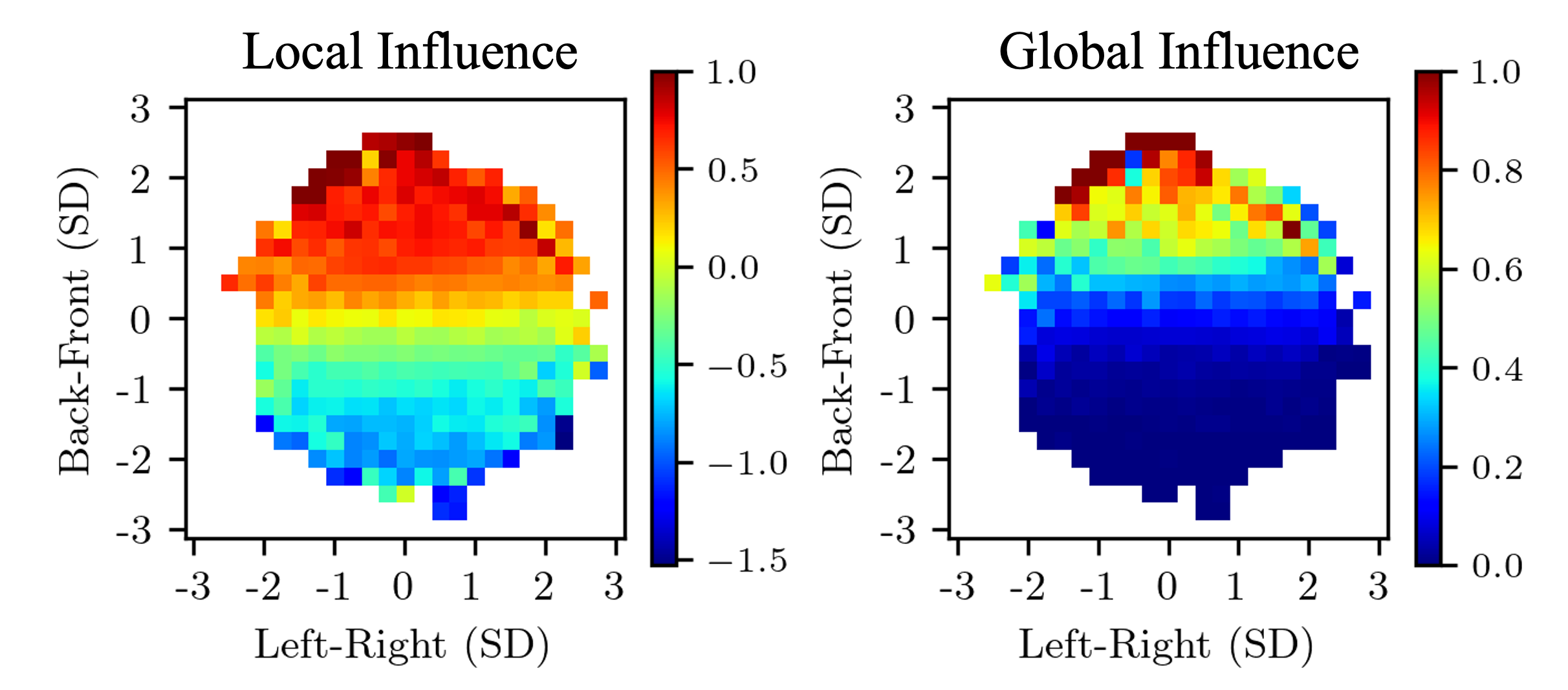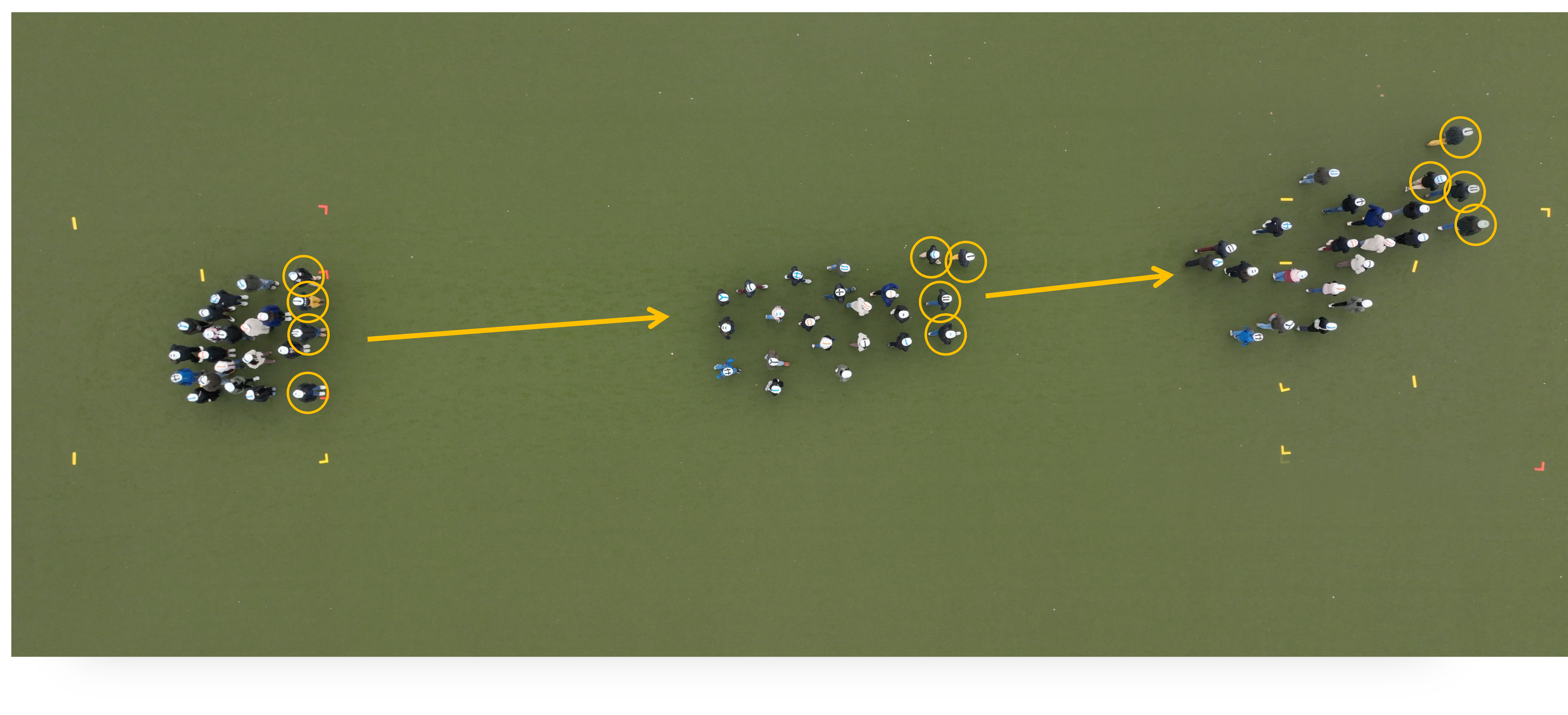Research
My PhD Research
My PhD research mainly focuses on these research questions:
- How do individual pedestrians influence each other and the collective motion of a crowd?
- How does their influence propagate through the crowd?
Visual influence networks in walking crowds
We introduced an approach that estimates local influences in observational data on moving human crowds and represents them as spatially-embedded dynamic networks (visual influence networks).

We also developed measures to quantify local and global influence strengths of individual pedestrians. We quantitatively showed the front of crowds as the most influential position.

Read more about visual influence networks in this preprint: https://doi.org/10.1101/2025.01.29.635594.
Click here to see the abstract
Collective motion in human crowds has been understood as a self-organizing phenomenon that is generated from local visual interactions between neighboring pedestrians. To analyze these interactions, we introduce an approach that estimates local influences in observational data on moving human crowds and represents them as spatially-embedded dynamic networks (visual influence networks). We analyzed data from a human “swarm” experiment (N = 10, 16, 20) in which participants were instructed to walk about the tracking area while staying together as a group. We reconstructed the network every 0.5 seconds using Time-Dependent Delayed Correlation (TDDC). Using novel network measures of local and global leadership (direct influence and branching influence), we find that both measures strongly depend on an individual’s spatial position within the group, yielding similar but distinctive leadership gradients from the front to the back. There was also a strong linear relationship between individual influence and front-back position in the crowd. The results reveal that influence is concentrated in specific positions in a crowd, a fact that could be exploited by individuals seeking to lead collective crowd motion.
Experiment with Covert and Explicit Confederates
In this experiment, we strategically placed covert or explicit leaders (confederates) at previously shown influential positions in a group of walking pedestrians. We instructed them to change walking direction (heading) on a signal. Participants were either told to follow the crowd (covert) or follow the confederates with flags (explicit), and we tested the confederate influence on collective motion.

I presented this work in 2024 at Traffic and Granular Flow, and the conference proceedings have been published. Read more about this experiment and the initial findings here: https://doi.org/10.1051/epjconf/202533404010.
Simulating the Participant Trajectories in the Experiment
I am currently working on simulating the participant trajectories with existing pedestrian models, treating the covert leaders’ motion as input, and test model agreement with the experimental data.
More results coming soon!
I presented this work in 2025 at Pedestrian and Evacuation Dynamics.
Publications & Presentations
Publications
Yoshida, K., Taylor, H., & Warren, W.H. (2025). The influence of explicit and covert leaders on human crowd motion. EPJ Web of Conferences, 334, 04010. https://doi.org/10.1051/epjconf/202533404010
Yoshida, K., di Bernardo, M., & Warren, W.H. (2025). Visual influence networks in walking crowds. biorxiv. https://doi.org/10.1101/2025.01.29.635594
Warren, W. H., Falandays, J.B., Yoshida, K., Wirth, T.D., & Free, B.A. (2024). Human crowds as social networks: Collective dynamics of consensus and polarization. Perspectives on Psychological Science, 19(2), 522–537. https://doi.org/10.1177/17456916231186406
Presentations
I have presented my work and met great scientists at a few conferences, including:
- Pedestrian and Evacuation Dynamics ([2023], [2025])
- Traffic and Granular Flow ([2024])
- Annual Meetings of Vision Science Society ([2022], [2023], [2024])
- Annual Meetings of the Psychonomic Society ([2019], [2020])
Click here to see a selection of my presentations
- Yoshida, K., Feldmann, S., & Warren, W.H. (2025, September 11). Simulating and Quantifying the Influence of Covert and Explicit Leaders on Human Crowd Motion [Conference session]. Pedestrian and Evacuation Dynamics 2025, Prague, Czech.
- Yoshida, K., Taylor, H., & Warren, W.H. (2024, December 4). The Influence of Explicit and Covert Leaders on Human Crowd Motion [Conference session]. Traffic and Granular Flow 2024, Lyon, France.
- Yoshida, K., Taylor, H., & Warren, W. H. (2024). Can covert and explicit “leaders” steer and split real human crowds? Journal of Vision, 24(10), 1325–1325. https://doi.org/10.1167/jov.24.10.1325 (Poster presented for the Annual Meeting of the Vision Science Society, 2024, in St. Pete Beach, FL, USA).
- Yoshida, K., & Warren, W. H. (2023, June 28). Structural analysis and topological manipulation of visual influence networks in walking crowds [Conference session]. Pedestrian and Evacuation Dynamics 2023, Eindhoven, Netherlands.
- Yoshida, K., & Chihak, B. (2020, November 21). The transfer of perceptual-motor recalibration between virtual and naturalistic environments [Poster presentation]. 61st Annual Meeting of the Psychonomic Society, held virtually.
- Chihak, B., Yoshida, K., & Bordwell, J. (2019, November 15). Simple models of movement coordination account for limited portions of pedestrian road-crossing behavior in virtual environments [Poster presentation]. 60th Annual Meeting of the Psychonomic Society, Montreal, QC, Canada.
- Yoshida, K., Shrestha, A., & Chihak, B. (2018, November 10). How roadway design affects cyclist-motorist interactions [Poster presentation]. 2018 Tri-State Undergraduate Psychology Conference, Loras College, Dubuque, IA, USA.
Previous Research
Perceptual-motor recalibration in naturalistic and virtual environments
I wrote about this work in my undergraduate honors thesis. We also presented a poster on this work in 2020 at the 61st Annual Meeting of the Psychonomic Society (held virtually).
Click here to see the abstract
The way people learn to interact with the physical world can be conceptualized as a perception-action loop. For new situations, existing schemes are used to make predictions, take actions, and adjust actions based on the feedback. Through this system, people can adapt their motions, such as walking and turning, as environmental conditions change. This locomotive recalibration has been investigated in several experiments in the naturalistic environment. However, there has been less research examining recalibration effects in immersive virtual environments which allow for studies with lower costs and smaller facilities. Further experiments in virtual environments are necessary in order to gain a better understanding of the processes underlying recalibration effects. The present research investigated (1) how perceptions and actions work together and (2) how people respond differently to virtual and naturalistic environments. Specifically, it examined whether a recalibration effect created in a virtual environment had the same characteristics as rotational locomotion in the naturalistic environment. It followed the designs of previous experiments in naturalistic environments and consisted of a pre-test, recalibration phase, and a post-test. The results indicated that there is the same recalibration effect in naturalistic and virtual environments, and rotational recalibration effects transfer between naturalistic and virtual contexts.
Simple models of movement coordination account for limited portions of pedestrian road-crossing behavior in virtual environments
We presented a poster on this work in 2019 at the 60th Annual Meeting of the Psychonomic Society (Montreal, QC, Canada).
Click here to see the abstract
The ability to coordinate self-movement with the movements of other objects is an important survival skill. Movement coordination tasks such as navigating across a busy intersection have high consequences for failure. Critical to reducing the injury rates of roadway users is understanding what perceptual information and movement control strategies individuals use to cross heavily trafficked streets. A number of models of movement control have proposed simple perceptual mechanisms to explain how humans coordinate self- and object-movement. However previous research in virtual environments has shown that no movement strategy based on a single perceptual variable adequately describes how drivers, bicyclists, and pedestrians cross through gaps in traffic. Instead, findings suggest that people crossing busy intersections are employing complex road-crossing strategies that are likely the product of a number of perceptual processes. In the current study, participants were asked to walk through target gaps in a single lane of bicycle traffic presented in a virtual environment. Preliminary results suggest that pedestrian road-crossing behavior may consist of a predictable combination of simple movement control strategies.
How roadway design affects cyclist-motorist interactions
We presented a poster on this work in 2018 at the Tri-State Undergraduate Psychology Conference (Loras College, Dubuque, IA, USA).
Click here to see the abstract
As the global population continues to concentrate into urban environments, the number of conflicts and collisions between different types of roadway users are increasing. In order to share the limited roadway space as efficiently and safely as possible, it is imperative that researchers investigate how pedestrians, bicyclists, and motorists interact with each other. Behavioral work in other labs investigating the overtaking of bicyclists by motorists has begun to explore how cyclists and motorists share the road. In this study, we built and programmed a multi-sensored, GPS-aware distance measurement system based on the Arduino microprocessor. The position-recording capability allows us to identify the specific mechanisms through which roadway features such as bike lanes and sharrows affect the cyclist-motorist interaction. Over a period of five weeks the experimenters rode the instrumented bicycle on city streets and recorded the lateral safety margin motorists afforded the bicyclists while overtaking. As the last phase of the project, all the data collected are currently being processed and analyzed. The development of this novel data collection methodology will strengthen the overall research field by providing a real-world validation of work conducted in laboratory contexts. The end goal of enhanced understanding of how cyclists and motorists interact on the roadway is likely to yield tangible real-world safety benefits for all roadway users.



